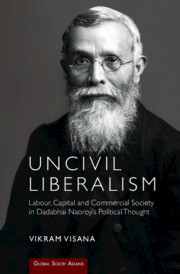Book contents
- Frontmatter
- Dedication
- Contents
- List of Abbreviations
- Acknowledgements
- Introduction
- 1 Sociality in an Imperial and Industrial Age
- 2 Sociality and the Parsis of Western India
- 3 Civil Society and Social Reform
- 4 Conceptualizing the Drain Theory
- 5 Making Commercial Society in India
- 6 Making Commercial Society in Britain
- 7 The Afterlives of Naoroji’s Political Thought
- Conclusion
- References
- Index
1 - Sociality in an Imperial and Industrial Age
Published online by Cambridge University Press: 27 September 2022
- Frontmatter
- Dedication
- Contents
- List of Abbreviations
- Acknowledgements
- Introduction
- 1 Sociality in an Imperial and Industrial Age
- 2 Sociality and the Parsis of Western India
- 3 Civil Society and Social Reform
- 4 Conceptualizing the Drain Theory
- 5 Making Commercial Society in India
- 6 Making Commercial Society in Britain
- 7 The Afterlives of Naoroji’s Political Thought
- Conclusion
- References
- Index
Summary
In February 1866 the retired Scottish physician and colonial administrator Sir John Crawfurd launched an epistemic assault on the alleged racial and cultural incapacity of Asians for ‘progress’. Delivered at the London Ethnological Society, Crawfurd's paper ‘On the Physical and Mental Characteristics of the European and Asiatic Races of Man’ enumerated the racial and sociological deficiencies of Asians, from their physical weakness to the inferiority of their literary output, invoking prominent utilitarian and liberal intellectuals like James Mill to bolster his argument. Dadabhai Naoroji had arrived in the United Kingdom eleven years earlier as a cotton trader based in Liverpool and by 1859 had relocated to London, where he was firmly enmeshed in the city's intellectual associations and political life. Taking exception to what he regarded as Crawfurd's libellous attacks on Asian culture, Naoroji launched a scholarly counter-attack a month later in his own paper entitled ‘The European and Asiatic Races’. The indignant Parsi offered copious examples of Asian literary and political genius. However, in instances in which India did display ‘illiberal’ tendencies, Naoroji interpreted and deployed his own selection of liberal concepts in order to historicize Indian development through a comparative stadial theory of ‘progress’ and so counter Crawfurd's orientalism and racism.
The subsequent chapters of this book explore Naoroji's engagement with liberalism and how ideological experimentation with this ideology allowed him to innovate a universal theory of plural sociality. Even though European liberals did not fully integrate cultural or class difference in practice, in Naoroji's estimation liberalism was open to conceptual experimentation and held out the potential for a more solidaristic politics. This chapter examines the writings of British liberals, political economists and their critics across the long nineteenth century in an effort to conceptually disaggregate forms of liberal sociality under the two broad headings of civil and commercial society. The rationale here is to evaluate liberalism's capacity to promote sociality across different cultural and class groups using the variety of thinkers we know Naoroji to have read. In so doing, the immanent potential Naoroji recognized in these traditions is outlined before we turn to how he renovated them in India.
- Type
- Chapter
- Information
- Uncivil LiberalismLabour, Capital and Commercial Society in Dadabhai Naoroji's Political Thought, pp. 27 - 50Publisher: Cambridge University PressPrint publication year: 2022

